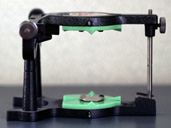
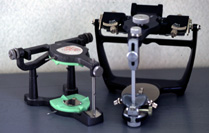
The Hundy Articulator which most
dentists, and technicians have. (in Japan?)
A right Articulator and a left Articulator. It mounts the same
model.
An intercondylar distance is wrong, too.
A distance to incisal border of the Upper first incisor tooth from
the condylar ball is wrong, too.
In other words, both a Bonwill's triangle and a Balkwill angle are
wrong.
In these two Articulators when it mounts the same model, do you think
that the same method is all right???
With being natural, there is no face bow in this Articulator.
Therefore, you must mount in the mean.
It mounted in three methods, and it was tried how to be different
inside the mouth in this Hundy Articulator.
First, it is a photograph in the mouth.



As the way of mounting, it transfered
the Camper's line by using the occlusion rim in the dentate Arch.
(About the occlusion rim in the dentate Arch , refer to the
"reality of the occlusion rim
in the dentate Arch")
A : Put an occlusion rim in the dentate Arch on the attached occlusal plane table as it is, and settle a Camper's line in the middle, and it mounts.
B : Raise a molar part to the attached occlusal plane table, and put it like the relations between the Camper's line and the Frankfort horizontal plane, and it mounts.
C : As for B, in the reverse, put it under the condition that a molar part is lowered, and it mounts. Make the attachment that a mount occurs because of that.
Let's try to verify the condition which mounts in the above method.
1) The upper jaw model mount ; The front view
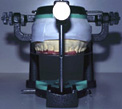 |
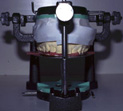 |
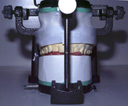 |
|
|
|
|
2) The upper jaw model mount ; The right side view
 |
 |
 |
|
|
|
|
3) The upper jaw model mount ; The left side view
 |
 |
 |
|
|
|
|
The attachment of this C is
manufactured by the hand made by a feeling if it was this side with
the plaster.
It mounts the lower jaw model in each of this condition.
Then, make it do a lateral movement, and it tries to verify it.
A used model, and a check bite material were made that it could
change it by using the same thing by the split cast mount
method.